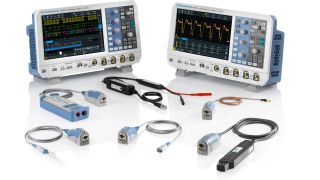The first step in selecting the right probe is to analyze the measurement task. Is the circuit to test connected to ground (meaning is a single-ended or a differential probe needed)? What is the maximum possible frequency of the signal (what bandwidth is required)? What is the maximum input voltage that can occur?
Differential or single-ended measurement
Differential probes are required when the circuit to test is not connected to ground, to make voltage measurements on switching power supplies, for example, or for low-noise measurements between differential signals. While there is no physical reason not to use a differential probe on a circuit connected to ground, in these circumstances the performance of a single-ended probe will be superior; a higher input impedance, a lower input capacitance, and a wider dynamic range.
Bandwidth and rise time
Bandwidth is one of the most important parameters when selecting a probe. It defines the effective maximum frequency that can be measured accurately with the probe; at the specified maximum frequency a signal will be displayed more than 3 dB (approx. 30%) weaker than it actually is. For accurate signal representation, the maximum frequency of both the oscilloscope and probe must be significantly greater than the highest frequency to be measured. When measuring digital signals, the measurement bandwidth should be 3 to 5 times greater than the clock rate; for debugging a digital design, a bandwidth 3 times greater is sufficient. For conformance tests on digital interfaces, the bandwidth must be 5 times greater than the clock rate.
When measuring fast rising signals (appearing with steep slopes on the oscilloscope display), such as when characterizing switching power supplies, the critical parameter is the rise time of the oscilloscope and probe. For precise measurements, the rise time should be a factor of 3 to 5 times lower than the rise time of the pulse being measured.
Dynamic range
The dynamic range of a probe defines the maximum measurable input voltage. It is specified for DC voltage and often decreases as the signal frequency increases. For differential probes, a distinction is also made between common mode and differential mode dynamic range. The common mode dynamic range specifies the valid input voltage range for a single differential input, measured with reference to ground. The differential mode dynamic range specifies the maximum measurable input differential voltage.
To accurately measure large-amplitude signals with fast rise/fall times, a sufficiently wide dynamic range must be available at high measurement frequencies. When measuring the residual ripple of DC switching power supplies, very small signals with a large DC component must also be measured. To make the full A/D converter resolution available, modern probes have the option to feed in a DC offset.
In the case of high voltage probes, operator safety is a key consideration. High voltage probes therefore have special insulation and other protective mechanisms to protect against accidental contact. These probes are characterized by the maximum voltage to ground, and also by measurement category. The measurement category defines the measurement environments in which the operator is protected. A probe may only be used in the measurement categories for which it is defined.
Load on the device under test
A measurement system must not excessively load the circuit under test, both to prevent degrading signals and to ensure that the functioning of the DUT is not impaired. The key is to use probes with a high input impedance and a low input capacitance. The resulting input impedance is highly dependent on the frequency and is typically less than 500 Ω at the probe's cutoff frequency.
Passive probes typically have an input impedance of 10 MΩ and an input capacitance of more than 10 pF. Active probes typically have an input capacitance of about 1 pF. It is important to select the right probe accessories for contacting with the DUT. Long pins and leads increase the capacitance and inductance, lower the maximum measurement bandwidth, and lead to excessive overshoot and ringing artifacts at the pulse slopes.
Expanded functions and probe accessories
In addition to the performance parameters, supplemental probe functions for simplifying daily tasks should also be considered. Examples in many Rohde & Schwarz active probes include an integrated digital voltmeter or a micro button. With the voltmeter, check the voltage without needing to change any connections. The micro button can be configured to provide direct control of the oscilloscope from the probe.
The diverse accessories offer flexibility during test point contacting, make the operator's day-to-day work easier and help prevent measurement errors. Available accessories include rigid and spring-loaded tips, browsers, adapters and extension leads. Rohde & Schwarz offers a comprehensive set of accessories for every probe.

























